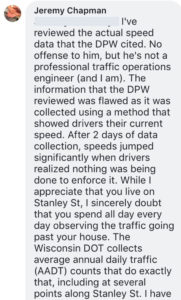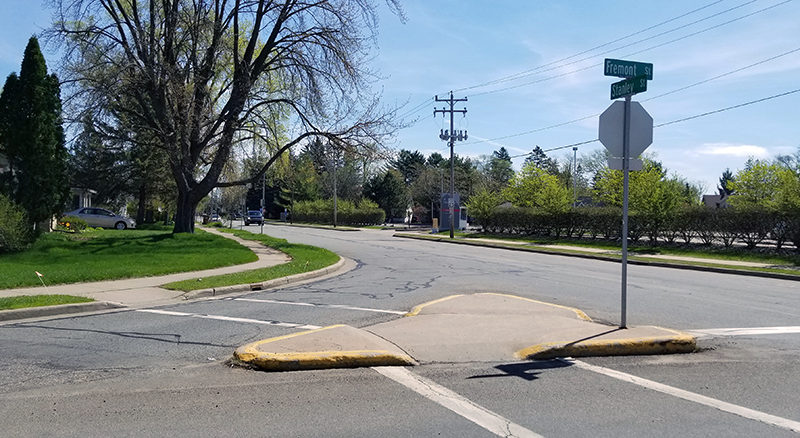Editorial: Stanley St. issue should go to referendum
By Brandi Makuski
Anyone who witnessed the 2013 public hearings on the Bus. 51 remodel remembers the heated debate that surrounded the proposal—and how quickly it rose to verbal fisticuffs.
There was a lot of shouting at those meetings; a lot of anger and more than a few cuss words were thrown around. A woman even threw her folding chair to the floor as she left one meeting in anger. The topic stirred ire in many where ever it came up, leading city officials at the time to back off.
A proposed road diet—a four-to-three lane conversion with bike lanes—on Stanley St. has created nearly as much debate and anger from some residents, but this time around the exchanges in public venues have been far more civil.
There are other differences as well: this time around, the proposal came from a member of the city council, rather than a recommendation by city staff. This time around, the city’s hand isn’t being forced by federal or state law—which at the time called for the inclusion of multimodal lanes on any reconstructed roadway in the federal highway system, which included Bus. 51. This time around, a majority of the city council doesn’t appear to be siding with the residents they serve.
This time around, no specific concern is being addressed with the proposed road diet.
Depending on the nature of objections, the council majority’s justifications have morphed from bicycle safety; to cyclists’ rights; to economic development; and most recently, took form in a somewhat patronizing and incredulous statement from one alderman who just can’t believe residents don’t see things his way.
Mayor Mike Wiza has repeatedly referred to the proposal as a “solution without a problem”, yet some on the city council seem surprised with the pushback, calling for civility as some residents voice continued opposition with some measure of passion. Some residents say they feel their objections have gone unheard by the council, and while the city engineer is open to changes at various parts of the roadway, he reports traffic counts along the corridor don’t meet DOT standards for a road diet.
Despite this, council members continue to argue in favor of the road diet—and insist they have been listening to constituents.
The proposal has taken an unusual journey and stems back to at least 2014. When public objection motivated the city to work on different options for a proposed reconstruction of Bus. 51, former Public Works Director Scott Schatschnedier said it was a project engineer at a local firm who made an off-the-cuff suggestion that Stanley St. would make an ideal “test case” for the purpose of calming concerns many residents expressed about installing bike lanes along Division St. The idea later went public when former Alderman Garrett Ryan introduced it during a 2016 city council meeting.
Later that year, anthropology professor and local bicycle enthusiast Tori Jennings (prior to running for city council) hosted two meetings in an attempt to explain installing road diets locally. One meeting was held at the Whiting Municipal Building in June and focused on a lane conversion for County Hwy. HH, but most village officials and residents weren’t impressed. The second meeting was held in September at Washington Elementary School and eyed Stanley St. as a candidate for the project.
Both presentations included video footage of a successful road diet in Tomahawk—a city with a population of about 3,000—along with a video of residents attempting to cross the busy intersection at Division and Dixon streets. The first video was referred to as a “case study”, although only supportive municipal officials were interviewed and no contradictory information was included, and while Schatschneider did agree the lane conversion would work on Stanley St.—and he called the idea “likely the only saving grace for Division St.”—he referred to the Tomahawk project as “a completely different corridor than Stanley St.”
Neither was an official municipal meeting, but both included a presentation on the importance of civic involvement from Nathan Sandwick, Community Development Educator for Portage County UW-Extension.
During her time as chairwoman of the now-defunct bicycle and pedestrian advisory committee, Jennings also made similar presentations before the city council.
In October 2016, Alderman David Shorr made an unexpected move to include a Stanley St. road diet in the 2017 capital budget. At that time, Schatschneider had outlined his department’s plans for repairing the city’s worst roads the following year, though Stanley St. was not among them. For the 2017 fiscal year, his department had $400,000 to perform an estimated $625,000 in roadway work. At the time, council members discussed the possibility of using the city’s contingency fund to pay for the re-striping.
Schatschneider resigned from his role in the city not long after.
Wiza organized a series of public meetings on Stanley St. designed to take constituent input and collect data before any decision was made, with the first held later that month. A second meeting was held last December. A final meeting was held in April and included an hour-long presentation from the city’s current public works director, Scott Beduhn, in which he addressed all concerns voiced by residents at previous meetings, as well as possible solutions for each.
Though many residents have voiced favor for some type of change—such as traffic controls at the intersection of Stanley St. and Minnesota Ave.—objections to bike lanes from residents and business owners along the roadway have been consistent, and at times, loud.
Some on the council, including District 10 representative Mike Phillips and Jeremy Slowsinki, of District 6, have said they do not support a lane conversion per direction in their districts. Others on the council, to include Shorr of District 2, Councilwoman Mary McComb of District 9, and District 8’s Cathy Dugan, remain unswayed and have, in some cases, told citizens their opinions were wrong.

Some on the council say they have heard from local supporters of the road diet; citizens who, they claim, are afraid to speak out publicly due to the hostility they say others bring to the debate.
Some on the council argue emotion has no place in deciding the future of Stanley St. They’re right: financial decisions based on emotion rarely turn out well. Facts and evidence alone should govern any financial decision made by a legal body such as the city council so the decision can withstand scrutiny.
Beduhn has presented options for the roadway. Data and studies have been provided and are publicly available on the city’s website.
But it’s done little to change the minds of the council majority, and some have announced they have new evidence, new experts, and new testimony prepared for Tuesday’s final meeting on the issue. One such expert is Jeremy Chapman, a project engineer in Indiana who admits he has not studied the corridor in person.
Chapman even took to a conversation on Facebook on May 12 to say the city’s engineer wasn’t an expert and, despite Beduhn’s months-long compilation of information from traffic studies, bike counts, and WisDOT claims he provided residents with inaccurate information. After Wiza stepped into the conversation to defend Beduhn, Chapman removed the remarks from social media.
Despite all the evidence presented thus far, many elements related to Stanley St. have gone undiscussed. Current uses of Stanley St. involve frequent logging trucks and emergency vehicles, and daily semi-truck deliveries and heavy equipment traffic to the businesses which call it home. Irregular events, such as the biannual fly-in at the Stevens Point Municipal Airport, place an additional 5,000-8,000 motorists on the roadway in a single day.
Future use of the road has also been, largely, glossed over. A rental complex on the former Division St. Kmart lot is expected to bring an additional 400 residents, plus visitors, to an area not far from Stanley St., putting additional traffic strain on all local roads.
The new Breast Care Center at St. Michael’s Hospital, with a parking lot entrance on Stanley St., opens this fall and is expected to treat thousands of patients annually, some of whom will utilize Stanley St.
Stanley St. is also expected to support thousands of extra vehicles daily while traffic is rerouted during this summer’s roundabout construction one exit to the north.
Combine the changes we know are coming with tourism numbers from the Stevens Point Area Convention & Visitors Bureau, which recently reported an almost three percent increase in tourism from 2016 to 2017, with visitors to the community spending over $128 million in the area last year alone. While it’s not realistic to believe all of those visitors used Stanley St., it’s reasonable to assume at least some of them did: Partner’s Pub, Rock-n-Roll Cafe, the Stevens Point Municipal Airport and Jordan Park all draw visitors to the community.
Stanley St. is not a neighborhood street: it an arterial roadway into Stevens Point, a growing city which saw record growth in 2017.
If city council members are to truly represent their constituents, they will stop pouring more gasoline on this fire and simply send the issue to a referendum. Let the voters speak.
It is more than just a simple re-striping of lanes at stake here: it is the fragile public trust placed by voters in those who represent them on the council. Once that is broken, it can take years to rebuild.

